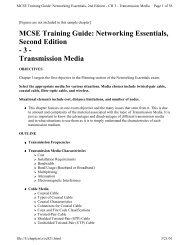SOCIAL PROBLEMS: A Down-to-Earth Approach, 8/e
SOCIAL PROBLEMS: A Down-to-Earth Approach, 8/e
SOCIAL PROBLEMS: A Down-to-Earth Approach, 8/e
Create successful ePaper yourself
Turn your PDF publications into a flip-book with our unique Google optimized e-Paper software.
ALTERNATIVE STRATEGIES OF THE ANTIABORTIONISTS. Antiabortion groups have tried <strong>to</strong><br />
persuade the states <strong>to</strong> restrict the Supreme Court’s ruling. They have succeeded in eliminating<br />
federal funding of abortions for military personnel and their dependents, federal<br />
prisoners, and workers with the Peace Corps. They have also succeeded in eliminating<br />
health insurance coverage of abortions for federal employees. Their major vic<strong>to</strong>ry on the<br />
federal level <strong>to</strong>ok place in 1976, when opponents of abortion persuaded Congress <strong>to</strong> pass<br />
the Hyde Amendment, which prohibits Medicaid funding for abortions except <strong>to</strong> save a<br />
woman’s life. When the Supreme Court upheld this amendment in 1980 (Lewis 1988),<br />
the number of abortions paid for by federal funds plummeted from 300,000 a year <strong>to</strong> just<br />
17. Despite repeated attempts <strong>to</strong> change the Hyde Amendment, the antiabortion forces<br />
have succeeded in retaining it.<br />
A highly effective strategy of the antiabortion groups is the establishment of a national<br />
network of “crisis pregnancy centers.” Women who call “pregnancy hotlines” (sometimes<br />
called life lines or birth lines) are offered free pregnancy testing. When they accept it, they<br />
are directed <strong>to</strong> counselors who encourage them <strong>to</strong> give birth. The counselors inform<br />
women about fetal development and talk <strong>to</strong> them about the financial help and social support<br />
available <strong>to</strong> them during pregnancy. They also advise the women about how <strong>to</strong> find<br />
adoptive parents or how <strong>to</strong> obtain financial support after the birth. Some activists also<br />
operate maternity homes and provide adoption services.<br />
Neither side on this social problem is a single, organized group. Rather, this is a social<br />
movement, and it has swept up people from every background, some of whom are<br />
moderate, others radical, and most somewhere in between.<br />
The moderates choose moderate alternative strategies. They call their friends, run<br />
newspaper ads, and write their representatives. Those in between picket abortion clinics.<br />
In the years after Roe v. Wade, some <strong>to</strong>ok their cue from the civil rights movement of the<br />
1950s and practiced passive resistance. Lying immobile in front of abortion clinics, they<br />
allowed the police <strong>to</strong> carry them <strong>to</strong> jail. In the late 1980s, antiabortion groups practiced<br />
massive nonviolent civil disobedience, and thousands of demonstra<strong>to</strong>rs were arrested. This<br />
social movement grew so large and its members so active that by 1990 more abortion protesters<br />
had been arrested than the number of people who were arrested in the entire civil<br />
rights movement (Allen 1988; Lacayo 1991; Kirkpatrick 1992). Since then, with the U.S.<br />
Supreme Court upholding state laws that restrict demonstrations at clinics and the homes<br />
of clinic staff (Walsh and Goldstein 2000), protesters have become less active, and arrests<br />
have dropped.<br />
Radical activists, in contrast, lean <strong>to</strong>ward radical methods. They have thrown blood<br />
on abortion clinics, pulled the plug on abortion machines, jammed locks with superglue,<br />
set off stink bombs, and telephoned women at night with recordings of babies screaming.<br />
Radical activists also have burned and bombed abortion clinics. In the <strong>to</strong>wn in which<br />
I taught, Edwardsville, Illinois, a group kidnapped a physician and threatened his life if<br />
he did not shut down his abortion clinics. Radical activists have shot and killed seven abortion<br />
doc<strong>to</strong>rs, acts that have been condemned by both proabortionists and antiabortionists<br />
alike.<br />
ALTERNATIVE STRATEGIES OF THE PROABORTIONISTS. Proabortion groups, <strong>to</strong>o, have developed<br />
alternative strategies. Their counterattack has taken three primary forms: campaigning<br />
for proabortion politicians, lobbying lawmakers <strong>to</strong> vote against restrictive<br />
legislation, and seeking broad-based support by publicizing their position. They have<br />
stressed a dual message: Abortion is a woman’s private decision in which government<br />
should not be involved, and “without the right <strong>to</strong> choose abortion, any other guarantees<br />
of liberty have little meaning for women” (Michelman 1988). The proabortion forces have<br />
recruited women who had abortions when it was back-alley business <strong>to</strong> alert the public<br />
<strong>to</strong> what it would be like if the right <strong>to</strong> abortion were taken away. Their message: rich<br />
women flying <strong>to</strong> countries where abortion is legal, poor women victimized by unqualified<br />
underground abortionists, and thousands of women dying from illegal abortions.<br />
Much of the proabortionists’ strategy has been limited <strong>to</strong> fighting rearguard actions,<br />
<strong>to</strong> trying <strong>to</strong> prevent the antiabortionists from chipping away at Roe by getting states <strong>to</strong><br />
restrict abortion rights. In a preemptive move, proabortionists have succeeded in getting<br />
12 CHAPTER 1 HOW SOCIOLOGISTS VIEW <strong>SOCIAL</strong> <strong>PROBLEMS</strong>: THE ABORTION DILEMMA
















